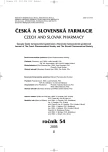In situ Gelling Polymers for Ophthalmic Drops
Authors:
Z. Šklubalová
Authors‘ workplace:
Katedra farmaceutické technologie Farmaceutické fakulty Univerzity Karlovy, Hradec Králové
Published in:
Čes. slov. Farm., 2005; 54, 4-10
Category:
Review Articles
Overview
One of the possibilities of how to optimize bioavailability of drugs after topical ophthalmic administration is prolongation of the period of contact of the preparation with the eye tissue. The most usual way of achieving this gaol is an increase in the viscosity of the preparation by an addition of a suitable auxiliary substance. At present besides hydrogels and mucoadhesive substances, also polymers which produce the sol-gel phase change are employed for this purpose. This so-called in situ gelation takes place in a very short period of time after contact with the eye tissue due to a change in temperature, pH, or interaction with physiological ions. The present paper aims to survey in situ gelling polymeric substances, which are examined in relation to their use in ophthalmic administration.
Key words:
ophthalmic drops – gelation in situ – polymers – polysaccharides
Labels
Pharmacy Clinical pharmacologyArticle was published in
Czech and Slovak Pharmacy

2005 Issue 1
Most read in this issue
- In situ Gelling Polymers for Ophthalmic Drops
- Enzymology of Production of Benzylisoquinoline Alkaloids
- Power Law Equation and Liberation Kinetics
- Prescription and Structure of Formulation of Medicinal Preparations in a Pharmacy II
